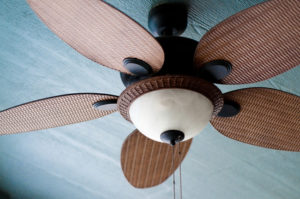 Ceiling fans provide enjoyable cooling with a fraction of the energy consumption caused by air conditioners. The power used by a ceiling fan varies depending on the model, the size, and the speed setting. Various units consume anywhere from 10 to over 100 watts per hour, with most running between 20 and 80 watts.
Ceiling fans provide enjoyable cooling with a fraction of the energy consumption caused by air conditioners. The power used by a ceiling fan varies depending on the model, the size, and the speed setting. Various units consume anywhere from 10 to over 100 watts per hour, with most running between 20 and 80 watts.
Let’s look at what these numbers mean and how they affect household energy consumption.
What the Ceiling Fan Wattage Numbers Mean
When shopping for a ceiling fan, you can usually find statistics for wattage and estimated annual costs. For a fan you already own, look for a label on the unit if you no longer have the packaging. Otherwise, manufacturer’s websites will have this information.
Here’s how you figure the operating costs based on ceiling fan wattage:
- Multiply the watts by your utility provider’s rate per kilowatt-hour (kWh). This rate can be found on your utility bill, but be sure to consider your total costs, i.e. “delivery” costs as well as fuel costs.
- A ceiling fan rated 25 watts with a household rate of $0.15 per kWh would cost about $33 per year. That’s running 24 hours a day, 365 days a year.
- Consider the costs of a larger, less-efficient fan of 75 watts and a higher electric rate of $0.25 per kWh. That would total about $165 running nonstop for a year, which is still less than two cents per minute.
- Estimate your actual costs by dividing the annual cost by the percentage of time you actually operate the ceiling fan, add the costs of multiple fans throughout the home.
In other words, if you run a ceiling fan 12 hour per day on average and use your ceiling fans 6 months out of the year—you are likely spending $10 to $40 per year, per ceiling fan.
Important note: Smaller fans and lower fan speeds do not necessarily translate to practical energy savings. Larger fans may use more watts but also deliver greater cooling power because they can circulate more air. Running your fans at a higher speed may also produce noticeably more comfortable results with a negligible increase in energy use.
Savings Compared to Air Conditioning
In our temperate bay climate around Marin and Sonoma counties, homeowners interested in cutting costs and going green should experiment with replacing central air conditioners and window units with the natural wind chill factor of fans.
Most central A/C units use anywhere from 2000 to 5000 watts. That’s why running your air conditioner can make up more than half of your utility bill and cost thousands of dollars per year.
Turning off the A/C when possible and using a ceiling fan instead can easily cut hundreds of dollars off of your annual electric costs.
Energy Star and Other High-Efficiency Models
The EPA’s Energy Star program certifies ceiling fans and other appliances for energy-efficient performance. Most ceiling fans with the Energy Star label draw around 20 watts while delivering an appropriate airflow.
Think of these units as certain options for eco-friendly, low-cost operation. For large rooms that need big ceiling fans, you can find efficient units that may not qualify for the Energy Star logo. A large, powerful ceiling fan (one with 52” blades or longer) can cool large spaces more efficiently than smaller units.
Talk to your trusty local electrician about installing modern, energy-efficient ceiling fans for an upgrade over old models and a drastic reduction in energy bills compared to relying on air conditioning.

